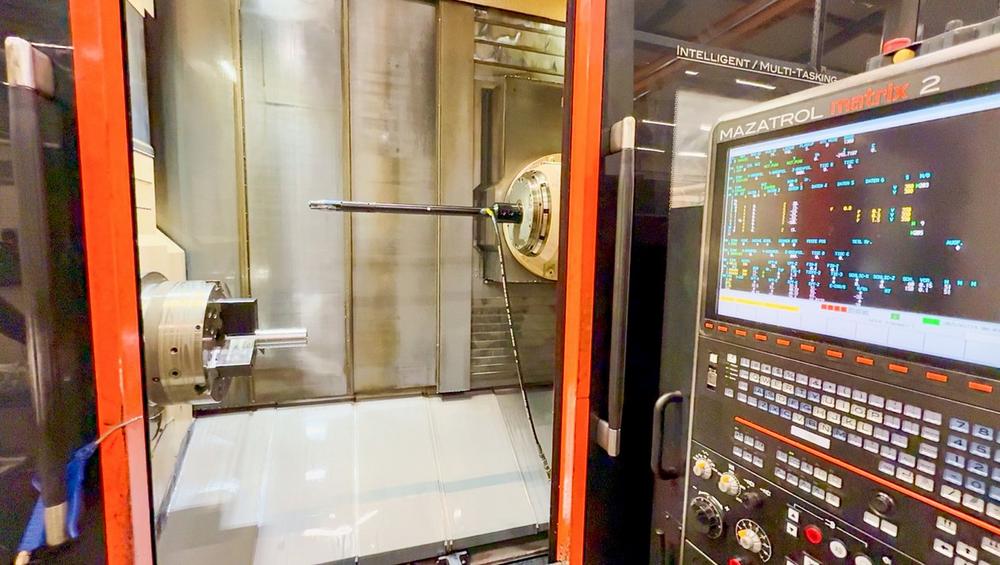For the cylinder, this means that ready-machined tubes are used, especially in cylinder tube production. The tubes are completely machined on the inside and only need to be cut to length and provided with connection dimensions. Today, tube production is carried out using the combined process of skiving and roller burnishing on deep drilling machines. This has significantly reduced the processing time compared to the honing process used in the past.
However, the question is whether, against the backdrop of rising prices, complete machining can be carried out on a standard machine tool in the company’s own production facility. This would increase flexibility and at the same time drastically reduce costs for the raw material.
SKIOC tools for peeling pipes on standard machine tools
ECOROLL has therefore adopted the principle of skiving and roller burnishing tools and adapted them for use on lathes or milling machines. With so-called SKIOC tools, tubes can now also be produced directly on the machine by internal skiving.
These tools consist of a tool body containing two or three skiving knives. Two special indexable inserts for internal skiving are arranged one behind the other on each skiving knife. First, the pre-cutter produces a uniform size within the bore, one could say it cleans the bore. The finishing cutter then produces the final surface with a cutting depth of ap= 0.1 – 0.2 mm.
The proven OMEGA principle has been adopted to create a perfectly round bore shape. The skiving knives influence each other. They are mounted on floating bearings so that pushing in one knife causes the other knife to extend. Guide rails then guide the tool accordingly within the existing bore.
Due to the number of two or three skiving knives and the orientation of the blade more in the axial direction, very productive cutting values can be achieved. A cutting speed of vc= 100 – 300 m/min combined with a feed rate of f = 1 – 3 mm is common for this process.
The tool is activated by the pressure of the cooling lubricant, which means that the knives not only remain stable on the machining diameter, but can also collapse after the process and be pulled out of the hole in rapid traverse. The surface created is not destroyed in the process. The machine must be retrofitted accordingly for activation. The requirements here are a pressure of at least 70 bar and a flow rate of 12-24 l/min.
The high flow rate is primarily required to support chip removal. Nozzles on the knives shoot the chips forwards out of the pipe. Unfortunately, it is not possible to discharge them to the rear, as is the case with conventional drilling. This leads to a second technical requirement for the machine: the chips must be guided safely out of the pipe.
The clamping device must be designed in such a way that there is an open chip space behind the tube. The picture shows, for example, an open lantern behind the clamping device, in which chips can be collected and also be ejected. The clamping device must then be individually designed for the component.
Productive processing of cylinder tubes by skiving and roller burnishing
The skiving, i.e. the machining process, already achieves a high roundness accuracy of IT8. At the same time, however, the surface result is also quite impressive. Using the example of a customer test, in which a tube made of 42CrMo4 was machined, we were able to achieve an average roughness depth of Rz= 8 µm and an arithmetic roughness of Ra= 2 µm. We worked at a cutting speed of vc = 175 m/min and a feed rate of f = 3.5 mm.
Of course, this surface quality is not yet sufficient for the production of a hydraulic cylinder. However, a conventional roller burnishing process with a multi-roller mechanical tool as the final machining step is then able to reduce the surface quality to an Ra value of Ra <0.1 µm. And this is a sufficient quality for the production of hydraulic cylinders.
ECOROLL AG Werkzeugtechnik
Hans-Heinrich-Warnke-Str. 8
29227 Celle
Telefon: +49 (5141) 9865-0
Telefax: +49 (5141) 881440
http://www.ecoroll.de
Marketing, PR
Telefon: +49 (5141) 986545
E-Mail: markus.boesel@ecoroll.de
![]()
